Asha Singh
 Questions of linguistic autonomy and annihilation of caste-gender oppressions are crucial for the struggles of an emerging Bahujan public sphere in Bhojpuri speaking regions. Ali Anwar, the Pasmanda Muslim Parliamentarian from the Bhojpuri region has often been in the forefront of asserting Bhojpuri autonomy in the Parliament.
Questions of linguistic autonomy and annihilation of caste-gender oppressions are crucial for the struggles of an emerging Bahujan public sphere in Bhojpuri speaking regions. Ali Anwar, the Pasmanda Muslim Parliamentarian from the Bhojpuri region has often been in the forefront of asserting Bhojpuri autonomy in the Parliament.
Within the Bhojpuri public sphere, Hindi is conceived either as a ‘colonizer’ or as a ‘nationalist’. These conceptions are often informed by the caste location and ideology of the conceiver. K.D. Upadhyaya, one of the foremost Bhojpuri socio-linguist, framed Bhojpuri as a language which would only strengthen the National Hindi. On the other hand, Bhojpuri has been also conceptualized as a language displaced by Hindi colonization. The latter view is gaining ground and strength. In this context, the Dravidian Movement does provide a historical and strategic text to further elaborate this position.
In such an exercise, it would become important to historically trace how Hindi was utilized by the native colonial elite in the so-called ‘Hindi’ heartland. The Vernacular Education Commissions of the late 19th century provides evidence of how the Brahmanical elite of Bihar (part of Bengal presidency) perceived Bhojpuri. George Grierson deposed that the upper castes of the region perceived Bhojpuri as a language of the ‘Doms and Dusadhs’ (lowered-castes) and thus incapable of greatness. On the other hand, Grierson held Bhojpuri and other Bihari languages as the gateway to the East and even categorized them separately. He even proposed the possibility of a common grammar for these languages.
This view of Bhojpuri as an unworthy language is not a new story. One finds its representation as a language of the ‘subordinate’ in not only Hindi but also Bengali Cinema. In fact, the recent letter written by Hindi Professors across the country against the inclusion of Bhojpuri in the eighth schedule is an excellent example. In the letter, manufactured from Calcutta University, the professors argue that Bhojpuri is a ‘lowly’ language as it has hardly authored classical texts such as ‘Ramcharitmanas’.
It should be noted the Bhojpurias consist the largest chunk of the so-called ‘Hindi speaking people’. Their autonomy would mean a drastic fall in the number of official ‘Hindi speakers’. Their numbers are estimated to be as high as twenty crores. Such movements for autonomy, with all their internal contradictions, are also found in other parts of the so-called ‘Hindi’ heartland.
In short, the fight against the Hindi-driven imperialism of the Indian State is being fought in multiple sites even within the imaginary category called ‘Hindi people’ and ‘Hindi states’. Learning about these struggles should be an important aspect of any discourse which attempts to challenge the idea of India. The nature of the Indian State cannot be an abstraction which blurs the identities of its actors. In other words, bringing down the Empire cannot be done without naming the ‘collaborators’ and the ‘players’ in their proper noun. When we start naming the players, a historical exercise, we realize that it is important to flesh out the content of Hindi/Non-Hindi binary. This is important to sharpen our idea of who embodies the powerful Hindi-subject. As G. Aloysius points out, the Brahmanical Elite (across the geography of the State) colluded with each other to manufacture a consensus on the Indian Ideology. Without an analysis of caste and gender, it is impossible to postulate any criticism on the Idea of India.
Talking about Bhojpuri it is important to at least briefly discuss the factors responsible for its present status. The role of the Brahmin-Savarnas of Bihar and Bengal in shaping the public sphere of colonial and postcolonial Bihar is noteworthy. While the control of the Bihari Savarnas over the material and culturally-valued resources was near complete, the Bengali Bhadralok controlled the colonial bureaucracy. Their combined might ensured minimum attempts to democratize public goods such as education. In fact, one would find them spearheading exclusive schools for their own upper-caste kith and kin. The Bihari lowered-castes, who form the majority of the state, languished under the fiefdom and tax-regimes of the Bengali bureaucracy and Bihari Savarnas. This collaboration has been extremely detrimental to Bhojpuri and its people.
One also finds enough evidence on how the Bengali and Bihari Savarna class prominently featured in establishing BHU, Hindi Prachar programmes and even guiding the course of Hindi through supervising important PhDs during the Colonial period. Such doctoral works established how Bhojpuri and other such languages are mere ‘dialects’ of Hindi. In other words, the story of Hindi imposition in the so-called ‘Hindi heartland’ was a result of an elaborate collaboration between the Brahmin-Savarnas across the Gangetic plain. This is a critical issue which needs the consideration of any scholar who is interested in opposing Hindi subjecthood and the Indian Nation. In their attempts, they, the Brahmin-Savarnas of the Arya-vrata, also embodied the real Hindi subject. It is this subject, which populated the Constituent Assembly and ensured the subordination of Bhojpuri.
If we do not encaste and gender the history of Hindi, we may get into the trap of racializing a large majority of the so called ‘hindi-speakers’ as colonizers without recognizing that they themselves witnessed their languages being erased under the weight of Hindi. This process of Hindi imposition is on-going. The recent case of Ruby Rai and Ganesh Kumar is also very instructive. Both of them, first-generation learners, were criminalized by ‘Hindi media’ for the ‘inability’ to answer questions or pronounce words in Hindi and English or write essays on Tulsidas. It should be noted that they come from ‘Hindi-imposed’ areas.
Let me also point out that the most powerful players in the Hindi media, bureaucracy or judiciary are upper-caste Hindu men. The recent survey of Subaltern Magazine in Patna is an excellent example of who shape the opinions and moorings of ‘Hindi’ journalism. Nearly 80% of all journalists and 100% of all editors in the top Hindi newspapers of Patna are upper-caste Hindu men.
The emergence of a Bahujan public sphere in Bhojpuri speaking regions has been comparatively stunted and slow. The Bhojpuri public sphere is also an emerging terrain which is disproportionately dominated by brahmin-savarna hindu men. Again, the presence of SC, OBC and Muslim women in this public sphere is in a very nascent stage and a matter of male hostility. The reason for this delay cannot be explained without history and sociology. As explained earlier, the clever collaborations of the Kayastha-Brahmin-Bhumihar-Rajput combine and the colonial Bengali bureaucracy have heavily contributed to this delay. And what one needs to recognize is that the emerging sphere speaks ‘Hindi’ and is reclaiming its language through Hindi. Was this a conscious choice? The answer is a clear no. It was a matter of imposition and a successful imposition of Hindi language. Unlike other languages such as Bengali, Tamil, Punjabi or Telugu, Bhojpuri hardly ever had a formal life in public offices or modern institutions. This ‘backwardization’ of Bhojpuri along with several other languages in the so-called Hindi heartland has played a very important role in keeping the region ‘backward’. The dismal numbers on several human development scores are intimately linked to what has been done to the ‘medium’ of communication in the region. This linguistic backwardization, coupled with the economic policies of the Colonial-Savarna rulers, has ensured a steady flow of migrants to urban centers across the country and especially Calcutta. I am a third generation Calcutta migrant from my family. The conditions of my migration were set by the Mandal Commission. However, my granduncle migrated with his cow to supply milk to Bengali Upper-Castes and my uncle worked in their jute-mills. All three of us speak ‘Bengali’ in Calcutta, for our language ‘Bhojpuri’ has a lot in common with ‘Bengali’.
When Dalit-Bahujan men and women from Bhojpuri speaking areas make use of ‘Hindi’ to build their public sphere and especially their literary sphere it should not be seen as an unconditional acceptance of Hindi Hegemony. Their use of Hindi is only a structural culmination of the Indian ideology. So, can this structural consequence be backtracked? No. The curious case of fighting the Brahmanic Hindi subject with Hindi may seem contradictory, but it is inevitable. bell hooks in her book, ‘Teaching to Transgress ‘ points out how the African Slaves brought to the shores of the Americas spoke a variety of languages. They were recultured in English by their White Masters. In doing so, the African slaves found a new language, which was inevitably the master’s language. However, they reworked the language, often changing the order of the words, using new words, speaking in a grammar unknown to the Master. This is not to say that ‘English’ in their context ceased to be hegemonic. I am just pointing out at the living possibilities of a language. Dalit-Bahujan and women ‘Hindi’ speakers often find themselves in such situation with Hindi. They often make use of expressions, idioms, and phrases which betray the core of ‘Sanatani Hindi’. This example is to only point out that the majority of ‘Hindi’ speakers do not have a receptive history or relationship with the language. Several subversions are attempted and will be attempted.
The structural culmination of Hindi hegemony is such that a Tamil Migrant in West Bengal or Purvanchal would be ‘termed’ a ‘hindi person’ if you go only by his/her language of communication. For example, my Malayalee husband is a ‘Hindi person’ in Calcutta, if we apply the same logic. He may continue to be a ‘Hindi or English person’ in my village in Bhojpur district of Bihar. A ‘pure’ Hindi speaker in the Bhojpuri countryside is perceived to be as alien as an ‘English speaker’. Thus, the easy association of speaking Hindi or ‘hindi-like’ languages with North India seems to be an excellent case of ad hoc empiricism. A ‘North Indian Worker’ in Chennai or Madurai or Trivandrum could be from east, west, north-east, and north of India – all of them are capable and sometimes only capable of using ‘Hindi’ as the link language. Again, does this mean that they are all ‘hindi people’? The use of Hindi or Hindi-like languages by them and several other migrant workers in formal and informal sectors cannot be the sole reason to list them as ‘foot soldiers’ of Hindi hegemony. Such a view is not only blinding but also dangerous.
Hindi as a language without a specific geography was manufactured for the Upper-Caste Hindu man of the Gangetic plains. Through Hindi he created and made claims to jobs in colonial administration and judiciary. One finds several examples of how this was done. Hindi was also the language which carried ‘Hinduism’ across the country. B.P. Sinha’s book titled the Kayasthas in the making of Modern Bihar lists the names and biographical sketches of Kayastha men who shaped ‘Hindi’ for the region; their numbers are not less than a few hundreds. They often served both Hindi and Hinduism through their books. They, along with other upper castes, shaped Hindi in opposition to Urdu and Persian, barricading government jobs for their kith and kin in the Gangetic plains. Thus, the educated elite of Bihar and U.P. betrayed their own ‘mother tongues’ to institutionalize Hindi. We are often taught that Bhojpuri is a ‘dialect’ of Hindi. As linguist Rajendra Prasad Singh points out, such statements are anti-historical, for one finds the presence of Bhojpuri prior to that of Hindi. Writing history backwards was necessary to consolidate the position of Hindi. The generation of men who institutionalized Hindi and Hindi hegemony ensured that other languages in the so-called ‘Hindi heartland’ be reduced to rural cultural artifacts and gendered kitchen lexicons. The present generations of these men are capable enough of leading their lives without ‘Hindi’ as a medium of communication. They live and operate in spaces which can afford ‘English’. In other words, they can even join hands with active strands of anti-hindi politics with the help of their English skills. For the vast majority that is relegated to speak and live and fight in ‘Hindi’ are the historical non-elites of the same region. This demographic shift needs special attention; it should also inform the fight against Hindi hegemony. The shift in the ‘hindi speaker’ and increasingly the ‘hindi researcher’, a result of Indian ideology, cannot be sidelined as a ‘complexity’ which does not interest anti-hindi scholarship. It is not a complexity but a fact that Bhojpuri speakers are not ‘Hindi people’. And when Bhojpuri speakers become Hindi researchers, they are non-hindi researchers of Hindi.
The problem lies with the idea of a fixed territory. There is an unfounded assumption that ‘Hindi’ has a natural, organic territory of its own. And everything within the boundaries of that territory is somewhat Hindi. Thus, the existence of different languages in this constructed territory (situated around the Gangetic plains) is seen as an ‘added complexity’ or an ‘internal matter’ of the Hindi speakers. Such a view is flawed, for it is confusing a Hindi imposed territory as a Hindi territory. Even New Delhi, gives us a dynamic map of languages. Punjabi, Haryanvi and Bhojpuri resist being called ‘Hindi’. Like Hinduism, Hindi is a legal fiction with real consequences on everyone. It has operated as an ideological apparatus for the Brahmin – Savarnas of the Gangetic plains and his affinities across the country, including the Bengali Bhadralok.
Thus, when Dalit-Bahujan women are entering Universities as ‘hindi’ speakers, they are attempting to break away from the imposition of caste and gender through education. For them, Hindi has an ‘instrumental value’. It is used as the only available tool to make claims to dignity. In doing so, they can be framed as the either perpetrator or victims of Hindi imposition. But one needs to move beyond these frameworks. Often, Dalit-bahujan women scholars utilize their education to ‘research’ their own languages and alter its popular representation in modern spaces. Placing such students against their Bengali or Tamil counterparts, using the binary of Hindi and Non-Hindi is not only unfair but also cruel. It is also historically unsound.
The question of federalism and sovereignty should be informed by the operations of caste and gender in a caste-gender valorized society. It is important for any analysis. Hindi imposition should be defined more expansively. A caste-gender blind analysis will be distorted and may racialize a Bahujan majority in the so-called ‘hindi’ heartland. Such an analysis is also important to understand that linguistic resources are not distributed evenly in any society. Thus it is important, to begin with a fundamental question such as who the Hindi-people are and which are the Hindi-states. Are Hindi-speakers, the ‘Hindi -People’? Who in these states are in a position to rob the dignity of ‘non-hindi’ speakers? If Bahujans are not the target, then it is important to explain the nature and character of the powerful Hindi subject. It is important to engage in such exercises to avoid indiscriminate and thus ad hoc attacks on populations that have suffered the greatest weight of Hindi.
Why do I say that the non-hindi speakers of the ‘hindi-imposed belt’ are the worst sufferers of Hindi? I have at least two reasons to support my argument. First, when I say ‘worst sufferers’, I do not intend to undermine the struggles of the non-hindi speakers of the South or any other part of the State. I only mean that unlike languages such as Malayalam or Tamil or Bengali, Bhojpuri did not have a script or a written system to oppose Hindi imposition. It existed and continues to exist largely as an oral language, with no literary sphere or a ‘literate’ population. The existence of written words, printing technologies, and a literate population are primary pre-conditions for such resistance. It is only today that we have an emerging literary sphere in Bhojpuri scripting its language in Devnagari. The non-existence of a written system is a result of upper-caste Hindu-hindi identity politics in the region. Second, owing to the imposed non-literate status of Bhojpuri, Dalit- Bahujans and others could access modern spaces only through Hindi. While, it should be noted that other languages in the South or elsewhere had their own competing spheres of modernity, which resisted Hindi. In such a situation, when formulating one’s own resistance lacks fundamental resources it was and continues to be difficult for Bhojpuri to share an equal platform with other non-hindi languages.
This essay does not deny Hindi hegemony, nor does it think that Hindi is irrelevant to the Indian Ideology. Further, I also recognize the denial of opportunities and racialization of ‘South Indians’ in the hands of the powerful Hindi subject. I have only tried to expand and inform the debate by stating up front the nature of the powerful Hindi subject. I do not believe that the onus of ‘understanding’ Hindi speakers lies on the shoulders of the ‘Tamil Nation’. On the other hand, I am arguing that there are no exclusive ‘Hindi people’. Bhojpuri or Awadhi or Magahi or Bundelkhandi speakers are as legitimately ‘non-hindi’ as Bengali or Malayalam speakers. The only difference being the former set of languages has faced the worst grudge of Hindi, swamping them away from all Modern spaces. This grudge of the powerful Hindi subject has been the biggest obstacle for Bhojpuri to enter written systems of communications. Irrespective of the constitutional status of a particular language, a non-hindi language remains a non-hindi language; there is no nation called Hindi to which it belongs. The territory of Hindi is as fictional as the territory of Hinduism. They are fictional but have real but varied consequences across the geography.
~~~
Asha Singh, is an Assistant Professor, Gender Studies at Centre for Studies in Social Sciences, Calcutta.
PS: This essay was written in English with the editorial support of Nidhin Shobhana. A fleshed out essay in Hindi will follow soon.










